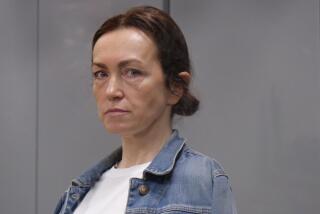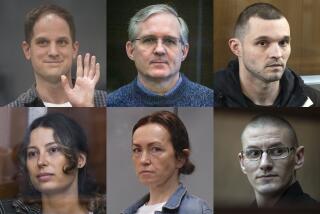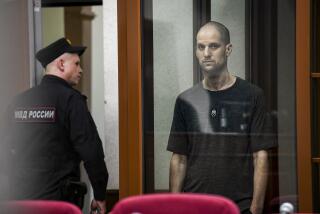Officials Say He ‘Made a Bad Mistake’ : U.S. Feared Soviets Could Make Daniloff Look Guilty
- Share via
WASHINGTON — U.S. officials said Wednesday that they went to unusual lengths to avoid a Soviet trial of American correspondent Nicholas Daniloff, partly for fear the Soviets could put together a seemingly credible espionage case.
They said their concern for what might come out of a Kremlin-orchestrated show trial stemmed from the fact that Daniloff acknowledged receiving a Russian map that turned out to be stamped “secret” and had contact with a Russian priest now believed to be a KGB agent.
The officials emphasized that they were not suggesting that they believed Daniloff was, in fact, involved in spying but that the Soviets might have been able to portray his actions in a light embarrassing to the U.S. News & World Report correspondent and to the United States.
U.S. officials from the President on down continue to proclaim Daniloff’s innocence of espionage charges. But a State Department official said Wednesday that in taking possession of the “secret” map from a Soviet acquaintance, Daniloff “made a bad mistake and something had to be done to correct it.”
Adding to their concern, an Administration source said, U.S. officials had detected signs that Daniloff was weakening under psychological pressures being applied to him in Moscow’s Lefortovo Prison. He was showing signs of “Stockholm syndrome”--the tendency of prisoners to identify with their captors--the official said.
“Daniloff had problems and that helps explain the extraordinary steps we took,” said one government official involved in the matter. “It was very, very important to avoid a trial.”
Such concerns help explain the complex deal engineered by the Reagan Administration to win his freedom. The agreement included the almost-simultaneous release of a Soviet spy in New York and Moscow’s agreement to free a prominent Soviet dissident in Siberia by Oct. 7, as well as next week’s meeting between President Reagan and Soviet leader Mikhail S. Gorbachev in Iceland.
‘Mentally Manipulated’
Responding to the suggestion that Daniloff was showing signs of Stockholm syndrome while in Soviet custody, U.S. News editor David R. Gergen said Wednesday: “I don’t know if I would go that far, but it was very clear he had been mentally manipulated. It seemed he was tiring at the end (of his imprisonment). . . . Over time, we thought mental torture could have an impact.
“They essentially can make you say black is white and then have you sign a document on it.”
Daniloff, in an interview Wednesday night, rejected the suggestion that he identified with his captors or sympathized with them. During his interrogation by a KGB colonel, Daniloff said, “it became clearer and clearer that he was bent on fabricating a case that would make me look like a spy.
“I always looked on him with considerable trepidation. There was no love lost,” said Daniloff, describing the sessions as “extraordinarily unpleasant.”
Map of Afghanistan
The potentially incriminating map depicted areas of Afghanistan and had the word secret stamped on it in Russian, according to a U.S. government source involved in the case. It was included in a group of documents that Daniloff received in the summer of 1985 from a Soviet acquaintance known to him as Misha. Daniloff has said he sent material from Misha to his magazine, but that it was not published.
Misha was later identified as Mikhail Anatolevich Luzin.
Daniloff was arrested by the KGB Aug. 30 in a Moscow park, immediately after Misha handed him another envelope containing photographs and maps, one of which the government source said was the same as the Afghanistan map he had been given a year earlier.
A U. S. News official described the document as “a very foggy picture of a map that appeared to be on a board--a troop placement thing.” It was among a number of photographs that Misha told Daniloff had been taken by Soviet soldiers and sent home from Afghanistan.
The other photos were of Soviet tanks and personnel in Afghanistan, a U.S. News official said. The material was stored in the magazine’s files and not printed, he said.
An intelligence source said he was puzzled by Daniloff’s dealings with Misha.
“Misha worked the hotels in Frunze,” the Soviet city where Daniloff first met him in 1982, the source said. “He introduced himself to foreigners and offered to show them the sights,” an activity he would not have been permitted to pursue without KGB endorsement, the source said.
By all accounts, the Russian priest, Father Roman Potemykyn, offered in December, 1984, to provide Daniloff with information about religious discord in the Soviet Union. Government sources said Daniloff grew wary of the man, who later was described by Ruth Daniloff, the correspondent’s wife, as “a bogus priest whom the KGB sicked on” her husband.
Envoy Expelled
A U.S. government source said the man, who referred to himself as Father Roman, was later contacted by Paul M. Stombaugh, a political officer with the U.S. Embassy in Moscow who was accused of spying, declared persona non grata and expelled from the country in June, 1985.
The government source, acknowledging that Stombaugh was a CIA case agent, said the Soviets were likely to cite his approach to Father Roman as evidence that Daniloff had close ties to the intelligence agency.
More to Read
Sign up for Essential California
The most important California stories and recommendations in your inbox every morning.
You may occasionally receive promotional content from the Los Angeles Times.










